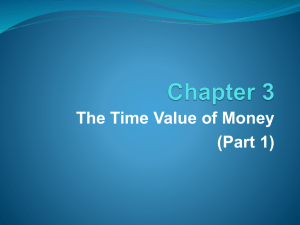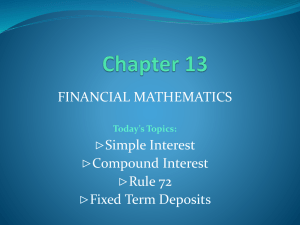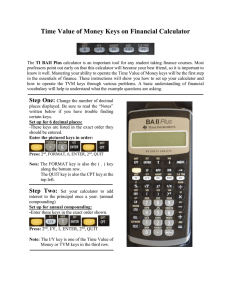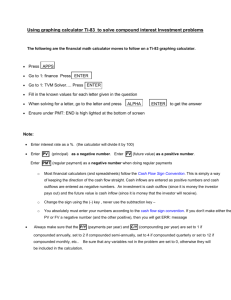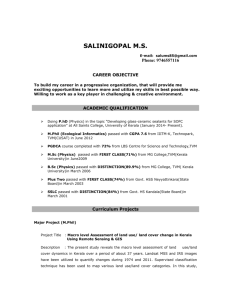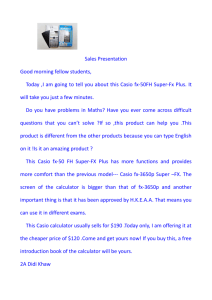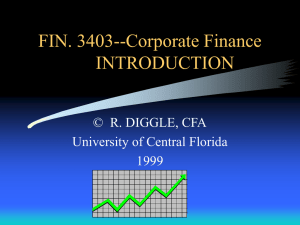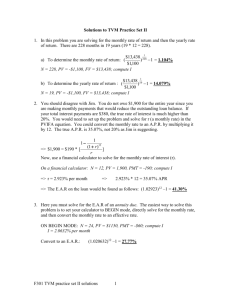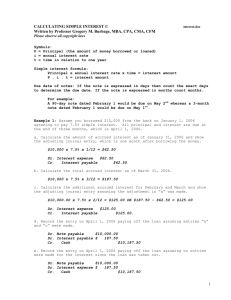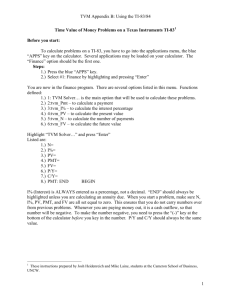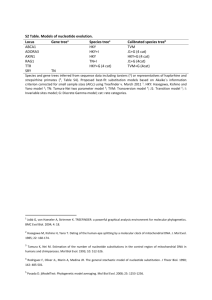Casio 9860 Self-Guided Instructions – TVM Mode
advertisement
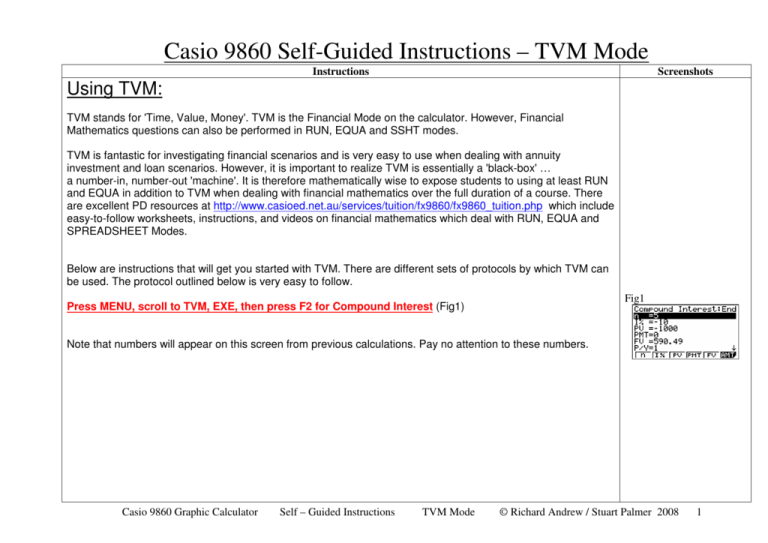
Casio 9860 Self-Guided Instructions – TVM Mode Instructions Screenshots Using TVM: TVM stands for 'Time, Value, Money'. TVM is the Financial Mode on the calculator. However, Financial Mathematics questions can also be performed in RUN, EQUA and SSHT modes. TVM is fantastic for investigating financial scenarios and is very easy to use when dealing with annuity investment and loan scenarios. However, it is important to realize TVM is essentially a 'black-box' … a number-in, number-out 'machine'. It is therefore mathematically wise to expose students to using at least RUN and EQUA in addition to TVM when dealing with financial mathematics over the full duration of a course. There are excellent PD resources at http://www.casioed.net.au/services/tuition/fx9860/fx9860_tuition.php which include easy-to-follow worksheets, instructions, and videos on financial mathematics which deal with RUN, EQUA and SPREADSHEET Modes. Below are instructions that will get you started with TVM. There are different sets of protocols by which TVM can be used. The protocol outlined below is very easy to follow. Fig1 Press MENU, scroll to TVM, EXE, then press F2 for Compound Interest (Fig1) Note that numbers will appear on this screen from previous calculations. Pay no attention to these numbers. Casio 9860 Graphic Calculator Self – Guided Instructions TVM Mode © Richard Andrew / Stuart Palmer 2008 1 The TVM protocols to be used are: n = number of time intervals (could be 8 years or 32 quarters or 96 months) I% = the per annum interest rate, as a percentage eg 11.5% is entered as 11.5 (not 0.115) PV = Present Value PMT = Payment, per time period FV = Future Value P/Y = It is best to consider both P/Y and C/Y as the number of compounding periods per year; ie both values will always be identical. (P/Y is meant to stand for 'payments/year' but this does not make sense for this protocol) C/Y = Same as P/Y Eg. If the investment (or loan) is compounding annually (once per year), then P/Y=C/Y=1. If the investment (or loan) is compounding quarterly (4 times per year), then P/Y=C/Y=4. If the investment (or loan) is compounding monthly (12 times per year), then P/Y=C/Y=12. NOTE: The dollar values (PV, PMT and FV) need to be entered either as positives or negatives, depending on the situation. This seems confusing at first, but is actually very simple. Consider each situation to be money either LEAVING your pocket OR RETURNING to your pocket. • If money is LEAVING your pocket, the number is entered as a negative. • If money is returning to you, the number is entered as a positive. Therefore: • receiving a loan of $5000: PV = 5000 • a regular payment from you of $260: PMT = -260 • investing $50 000: PV = -50 000 • an investment that will be worth $100 000 in 10 years time: FV = 100 000 Casio 9860 Graphic Calculator Self – Guided Instructions TVM Mode © Richard Andrew / Stuart Palmer 2008 2 Fig2 Below are two examples that involve a once-only investment that receives compound interest. Example 1: A sum of $2 000 is invested at 8%pa interest, compounded monthly, for 20 years. What is the future value of this investment? Enter the values as they appear in the question, pressing EXE after each entry. Leave FV as the pre-existing value. Check your entries with Fig2 NOTES: n=20x12; is the number of months. A good habit for students to enter n as (eg 20x12) so as to minimize careless error. I%=8; in TVM, the interest is always pa PV is negative because $2000 'left' your pocket PMT=0; there were no regular payments FV CAN BE ANYTHING! It is what we want to know so it makes no difference what number is showing here. P/Y and C/Y = 12; the interest compounds 12 times every year. P/Y and C/Y are always equal. Fig3 Fig4 Now press F5 for FV (Future Value). See Fig3. The answer can be read in the previous screen by pressing EXIT (Fig4) Note that FV is positive, not negative, because after 20 years the investment goes 'back into your pocket'. The investment has grown from $2000 to $9853.61 Example 2: What annual interest rate will be required for an investment of $12 000 to become $18 000 in 5 years, if the interest compounds annually? Enter the values as they appear in the question, pressing EXE after each entry. Check your entries with Fig5. NOTES: n=5 (years) I%=ANYTHING; It is what we want to know so it makes no difference what number is entered here. PV is negative because $12000 'left' your pocket. PMT=0; there were no regular payments FV is positive because $18000 will 'return' to your pocket in the future. P/Y and C/Y = 1; the interest compounds once a year. P/Y and C/Y are always equal. Now press F2 for the interest rate (Fig6) Casio 9860 Graphic Calculator Self – Guided Instructions TVM Mode Fig5 Fig6 © Richard Andrew / Stuart Palmer 2008 3 Fig7 Press EXIT to view solution in previous screen. (Fig7) Below is an example that involves repeated investments (an annuity) that receives compound interest. Example 1a): A sum of $2 000 is invested at the end of every year, at 8%pa interest, compounded yearly, for 20 years. What is the future value of this investment? Enter the values as they appear in the question, pressing EXE after each entry. Check your entries with Fig8. NOTES: n=20 (years) I%=8; in TVM, the interest is always pa. PV=0; the annuity started with nothing PMT is negative; each payment 'leaves' your pocket. FV CAN BE ANYTHING! It is what we want to know so it makes no difference what number is showing here. P/Y and C/Y = 1; the interest compounds once a year. P/Y and C/Y are always equal. Fig8 Fig9 Now press F5 for FV (Fig9) Press EXIT (Fig10) Fig10 Note that FV is positive, not negative, because after 20 years the investment goes back into your pocket. The investment was $2000 x 20, which is $40 000 (The investment has grown from $40 000 to $91 523.93) (to the nearest cent) Example 1b: What is the present value of the annuity in example 1a? OR What single investment (earning the same rate of compound interest for 20 years) would give the same future value as the repeated investments in example 1a? Enter the values as they appear in the question, pressing EXE after each entry. Check your entries with Fig11. Casio 9860 Graphic Calculator Self – Guided Instructions TVM Mode Fig11 © Richard Andrew / Stuart Palmer 2008 4 Fig12 NOTES: All that needs to change from the Q1a) entries is PMT to be changed to zero! The FV for 1b) is the same FV as in 1a). Now press F3 for PV (Present Value). See Fig12. Fig13 Press EXIT to view in original screen (Fig13) Note that PV is negative, not positive, because the money is leaving your pocket to make the single investment. A single investment of $19 636.29 NOW will produce the same result in 20 years. "Don't students get confused when being taught TVM because values have to entered differently to the formulae?" This is a question often asked by teachers learning TVM. The main difference of course, is that interest rates need to be entered as whole-pa-percentages into TVM but as per-time-period-decimals in the formulae. From experience, when teaching TVM protocols, if the formulae protocols are referred to simultaneously students understand quickly and with little confusion. Over the long term these differences prove to be a very minor disadvantage when compared to the ease and versatility of using TVM. TVM Graded Question Series: The 'Financial_Maths_TVM_Sheets 1-3' are an excellent, graded worksheet series with solutions designed for students to gain practice in using TVM. For further and more advanced information including practice questions refer to the manual 'Mathematics with a Graphics Calculator – Casio fx-9860 AU' by Barry Kissane & Marian Kemp, available at http://www.casioed.net.au/downloads/books/fx9860/orderBarryBook.pdf Casio 9860 Graphic Calculator Self – Guided Instructions TVM Mode © Richard Andrew / Stuart Palmer 2008 5
